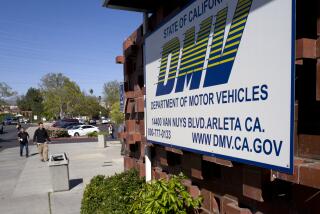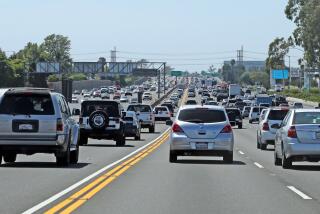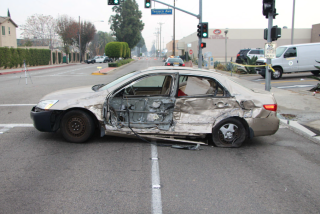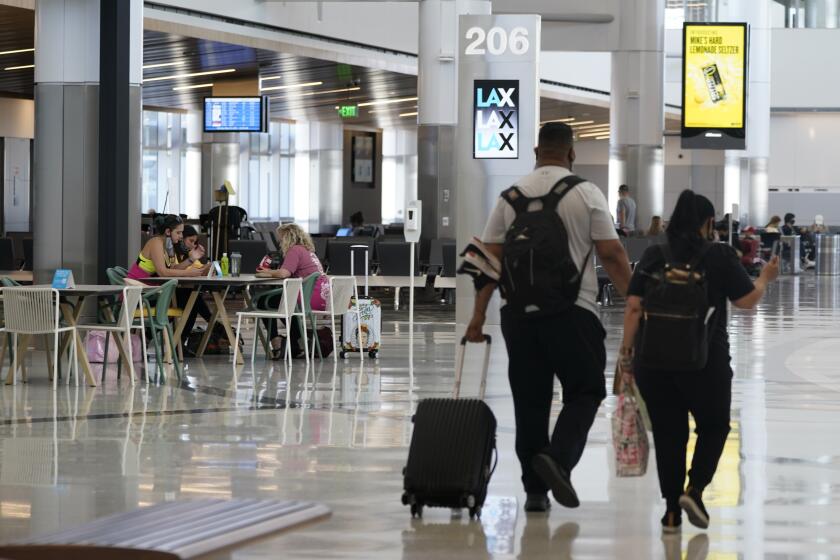Advice to Speeding Teens: Big Daddy (or Mommy) Is Watching
- Share via
Well, she got her daddy’s car
And she cruised to the hamburger stand now
Seems she forgot all about the library
Like she told her old man now
And with the radio blasting
Goes cruisin’ just as fast as she can now
And she’ll have fun, fun, fun
Til her daddy takes the T-Bird away.
--”Fun, Fun, Fun”, by the Beach Boys
Let her keep the T-Bird.
Just make sure you install a new gadget in the car that allows parents to monitor how fast their teen-agers drive.
The device sounds an alarm inside the car when the driver exceeds a preset maximum speed limit. Should Missy ignore the beep-beep-beep, Dad can later check the monitor to find out how fast the car was driven--and then he can ground Missy.
But that’s not all. Anxious parents are putting “How Am I Driving?” stickers on bumpers. Actually, these say: “How’s My Child’s Driving?” or “How Am I Driving? Call Mom or Dad!” and give a toll-free number that tipsters can call. (The sticker could go next to the one that reads: “My child is an honor student at . . . .”)
“Are you serious?” asked Danny Modaberpour, a 17-year-old senior at Taft High School in Woodland Hills when a reporter informed him of the toll technology was about to extract. “No way!”
“It wouldn’t help out at all,” said Farzad Heidari, a 16-year-old junior at Taft. “I’m still going to go fast,” he said, then thought better of it: “Not extremely fast.”
*
This latest in Big Brotherism--er, Parentism--is bound to be popular among parents of teens who tethered the children when they were toddlers, but psychologists raise concerns about such methods.
Commenting about the monitoring device, Janette Benson, associate professor of psychology at the University of Denver, said, “This is a sad commentary on the lack of trust between parent and child.”
Scott Geller, a Virginia Tech psychology professor, suggested that poor adult drivers could also benefit.
“Why should it be for kids only?” he said earnestly. “The kids could monitor their parents.”
The speed-tracking device, called DriveRight, is manufactured by Hayward, Calif.-based Davis Instruments. Its magazine ad shows a father relaxing in his easy chair, proclaiming: “His teen has the car. So how come he’s not worried?”
A password prevents teen-agers from tampering with the computerized device, which is about the size of a pocket calculator and sells for about $200. The data is protected for 10 days--”even if the wires are cut,” the manufacturer notes.
Actually, similar devices have been used for years by companies to monitor their employees’ driving.
Teen-age drivers are a cause of concern because of their disproportionately high accident rate.
Drivers ages 19 and younger accounted for 3.9% of California licensed drivers last year but represented nearly 9.2% of drivers in fatal collisions, the California Highway Patrol reported. Seven deaths were recorded per 10,000 licensed teen drivers--more than double the rate for drivers ages 25 to 35 and triple the death rate of drivers over 35.
*
Nationally, two of every three teens who died as passengers in 1993 crashes were traveling in vehicles driven by other teens, according to the Insurance Institute for Highway Safety.
CHP Sgt. Ernie Garcia, who moonlights as a driving instructor, said that teen drivers also have more of a tendency to speed than older motorists. He likes the speed monitor.
“Anything that can keep them honest would be a benefit,” he said.
Garcia, a father of five, is more skeptical of the “How Am I Driving?” bumper stickers.
“I don’t think that will do any good,” he said. “If somebody is just going to alert Mom or Dad, they’ll just deny it.”
Parents could better prepare their teens for safe driving by setting a better example--such as always buckling up and obeying speed limits, say traffic safety experts.
The insurance institute supports legislation requiring “graduated licensing” for teens. This can take the form of restricting novice drivers to daylight hours, or a 10 p.m. curfew for the first six months they are licensed. Proponents say it would allow young drivers to become more experienced before they moved onto more dangerous nighttime driving. Even if your state won’t pass such a law, you should impose such restrictions on your teen-ager, the insurance institute says.
A state Department of Motor Vehicles task force is studying graduated licensing, among other proposals, to reduce accidents involving teen drivers. It is expected to make recommendations next year.
But some officials say such restrictions would be difficult to enforce and would pose a hardship to students who work at night.
California in 1983 established a “provisional license” for 16- to 18-year-olds, allowing them fewer traffic violations than other drivers before they lose their license. The program has reduced accidents, officials say.
More to Read
Sign up for The Wild
We’ll help you find the best places to hike, bike and run, as well as the perfect silent spots for meditation and yoga.
You may occasionally receive promotional content from the Los Angeles Times.







